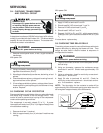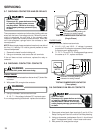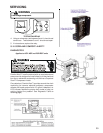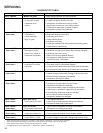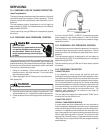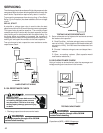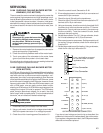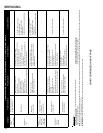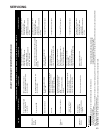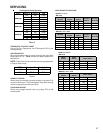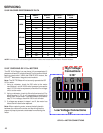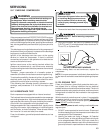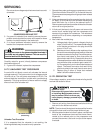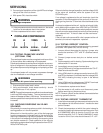
SERVICING
45
- Connectors are oriented "down"
(
or as recommended b
y
equipment manufacturer
)
.- Arran
g
e harnesses with "drip loop" under motor.
-
I
s con
d
ensa
t
e
d
ra
i
n p
l
u
gg
e
d?
-
Ch
ec
k
f
or
l
ow a
i
r
fl
ow
(t
oo muc
h
l
a
t
en
t
capac
ity)
.
-
Check
for
undercharged
condition
. -
Check
and
plug
leaks
in
return
ducts
,
cabinet
.
*Moisture Check
I
mpor
t
an
t
N
o
t
e:
U
s
i
n
g
th
e wron
g
mo
t
or
/
con
t
ro
l
mo
d
u
l
e vo
id
s a
ll
pro
d
uc
t
warran
ti
es an
d
ma
y
pro
d
uce unexpec
t
e
d
resu
lt
s.
Note:
You must use the correct replacement control/motor module since the
y
are factor
y
pro
g
rammed for specific operatin
g
modes. Even thou
g
h the
y
look alike, different modules ma
y
have completel
y
different
functionality. The ECM variable speed motors are c
CHART CONTINUED FROM PREVIOUS PAGE.
Symptom Fault Description(s) Possible Causes Corrective Action Cautions and Notes
- Stays at low CFM despite
system call for cool
or heat CFM.
- 24 Vac wires miswired or loose.
- "R" missing/not connected at motor.
- Fan in delay mode.
- Check low voltage (Thermostat)
wires and connections.
- Verify fan is not in delay mode -
wait until delay complete.
- Perform motor/control replacement
check, ECM motors only.
- Turn power OFF prior to repair.
Wait 5 minutes after
disconnecting power before
opening motor.
- Handle electronic motor/control
with care.
- Stays at high CFM.
- "R" missing/not connected at motor.
- Fan in delay mode.
- Is fan in delay mode? - wait until delay time complete.
- Perform motor/control replacement check, ECM
motors only.
- Turn power OFF prior to repair.
Wait 5 minutes after
disconnecting power before
opening motor.
- Handle electronic motor/control
with care.
- Blower won't shut off.
- Current leakage from controls
into G, Y, or W.
- Check for Triac switched t'stat
or solid state relay.
- Turn power OFF prior to repair.
- Air noise.
- High static creating high blower speed.
- Incorrect supply or return ductwork.
- Incorrect or dirty filter(s).
- Incorrect blower speed setting.
- Check/replace filter.
- Check/correct duct restrictions.
- Adjust to correct blower speed setting.
- Turn power OFF prior to repair.
- Noisy blower or cabinet.
- Loose blower housing, panels, etc.
- High static creating high blower
speed.
- Air leaks in ductwork, cabinets,
or panels.
- Check for loose blower housing,
panels, etc.
- Check for air whistling thru seams in
ducts, cabinets or panels.
- Check for cabinet/duct deformation.
- Turn power OFF prior to repair.
- "Hunts" or "puffs" at
high CFM (speed).
- High static creating high blower speed.
- Incorrect or dirty filter(s).
- Incorrect supply or return ductwork.
- Incorrect blower speed setting.
- Does removing panel or filter
reduce "puffing"?
- Check/replace filter.
- Check/correct duct restrictions.
- Adjust to correct blower speed setting.
- Turn power OFF prior to repair.
- Evidence of
Moisture.
- Motor failure or
malfunction has
occurred and moisture
is present.
- Moisture in motor/control module.
- Replace motor and perform
Moisture Check.*
- Turn power OFF prior to repair.
Wait 5 minutes after
disconnecting power before
opening motor.
- Handle electronic motor/control
with care.
- Motor starts,
but runs
erratically.
- Excessive
noise.
Troubleshooting Chart for ECM Variable Speed Air Circulator Blower Motors



